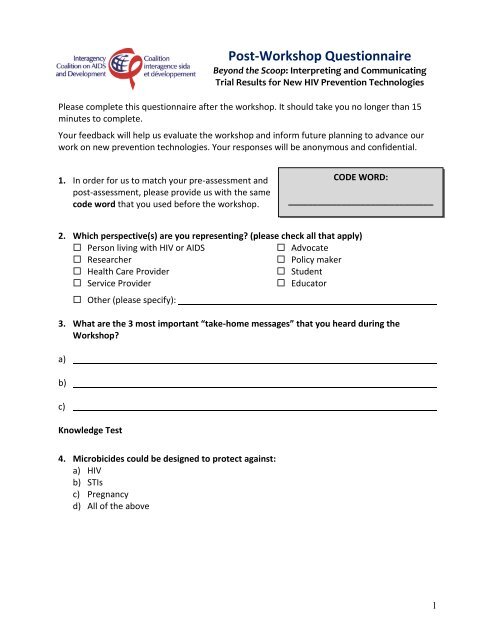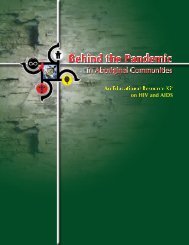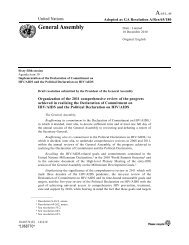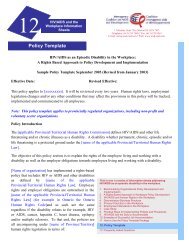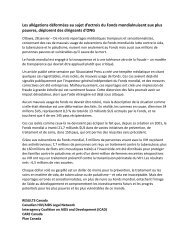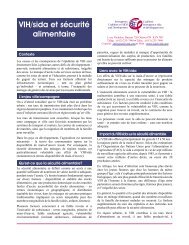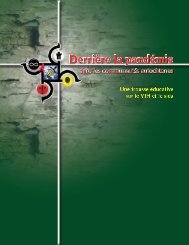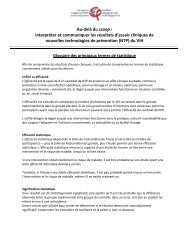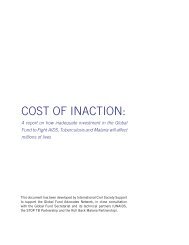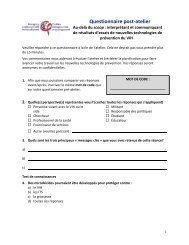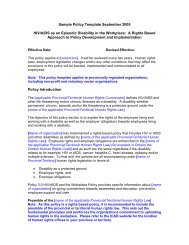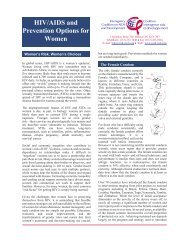Post-Workshop Evaluation Form
Post-Workshop Evaluation Form
Post-Workshop Evaluation Form
You also want an ePaper? Increase the reach of your titles
YUMPU automatically turns print PDFs into web optimized ePapers that Google loves.
<strong>Post</strong>-<strong>Workshop</strong> Questionnaire<br />
Beyond the Scoop: Interpreting and Communicating<br />
Trial Results for New HIV Prevention Technologies<br />
Please complete this questionnaire after the workshop. It should take you no longer than 15<br />
minutes to complete.<br />
Your feedback will help us evaluate the workshop and inform future planning to advance our<br />
work on new prevention technologies. Your responses will be anonymous and confidential.<br />
1. In order for us to match your pre-assessment and<br />
post-assessment, please provide us with the same<br />
code word that you used before the workshop.<br />
CODE WORD:<br />
______________________________<br />
2. Which perspective(s) are you representing? (please check all that apply)<br />
Person living with HIV or AIDS<br />
Advocate<br />
Researcher<br />
Policy maker<br />
Health Care Provider<br />
Student<br />
Service Provider<br />
Educator<br />
Other (please specify):<br />
3. What are the 3 most important “take-home messages” that you heard during the<br />
<strong>Workshop</strong>?<br />
a)<br />
b)<br />
c)<br />
Knowledge Test<br />
4. Microbicides could be designed to protect against:<br />
a) HIV<br />
b) STIs<br />
c) Pregnancy<br />
d) All of the above<br />
1
5. _______________ can be defined as administering medications used in the treatment of<br />
HIV to "high risk" HIV-negative individuals in hopes of preventing transmission of the virus.<br />
a) Proactive Highly Active Antiretroviral Treatment<br />
b) <strong>Post</strong> Exposure Prophylaxis<br />
c) Pre Exposure Prophylaxis<br />
d) Harm Reduction<br />
6. All of the following would make a drug a good candidate for Pre Exposure Prophylaxis<br />
EXCEPT:<br />
a) Easy to use: Only one pill required per day (maybe less).<br />
b) Safe: Few side effects in HIV-positive people.<br />
c) Sedative: Makes a person sleepy so they don’t engage in risky behaviours<br />
d) Powerful: Stays in the bloodstream a long time.<br />
e) Unique resistance profiles: If resistance develops, other treatment options still exist.<br />
7. A vaccine works by:<br />
a) teaching the body to recognize an infectious agent<br />
b) laying dormant, then attacking an infectious agent once it invades the body<br />
c) helping the body remain healthy despite an infection (keeps it in check)<br />
d) layering cells in protective armour<br />
8. Clinical trials are:<br />
a) A process of testing products in humans<br />
b) A process of testing products in animals<br />
c) A process of testing products in the laboratory<br />
d) A process of administering products in clinics<br />
9. “Informed consent” in clinical trials is:<br />
a) A group education process that includes signing an agreement with other potential<br />
volunteers in the trial<br />
b) The continuous process of explaining to volunteers all information about a clinical trial<br />
or study to ensure that they understand and independently sign an agreement before<br />
joining<br />
c) The process of informing a participant about a trial<br />
d) The consent given by volunteers to receive information about a specific issue<br />
2
10. Effectiveness of an NPT refers to:<br />
a) The cost of producing the NPT compared to the profit from the NPT<br />
b) The ability of a NPT to reduce incidence of the disease in the community<br />
c) The ability of a NPT to produce an immune response against the disease<br />
d) The ability of a NPT to produce an immune response in the shortest time possible<br />
11. Efficacy of a NPT refers to:<br />
a) The ability of the NPT to prevent infection or disease in the trial population<br />
b) The ability of the NPT to protect against diseases other than the one it was intended for<br />
c) The ability of the NPT to protect against the disease 100% of the time<br />
d) The ability of the NPT to produce quick results<br />
12. Randomisation in clinical trials is:<br />
a) A process of choosing at random which participants will get the candidate product or<br />
the placebo<br />
b) A random process of choosing countries where the NPT trial is going to be conducted<br />
c) A random process of selecting people from the population to be part of the NPT trial<br />
d) When a participant makes a choice to belong to either the placebo group or the<br />
candidate product group<br />
13. A placebo is:<br />
a) A place where the NPT is being tested in animals<br />
b) A substance that is given to volunteers to reduce potential side effects<br />
c) A harmless, inactive substance that resembles the candidate product in appearance<br />
d) A chemical substance used to determine when someone was infected by HIV<br />
14. The main objective of a Phase I clinical trial is to find out if the candidate product:<br />
a) Is safe<br />
b) Causes an immune response<br />
c) Protects against infection or disease<br />
d) Causes disease<br />
15. The main objective of Phase III clinical trial is to find out if the candidate product:<br />
a) Is safe<br />
b) Provokes an immune response<br />
c) Protects against infection or disease<br />
d) Causes disease<br />
3
16. What was your favourite part of the workshop?<br />
What was the least enjoyable / valuable part of the workshop?<br />
17.<br />
Please indicate your agreement<br />
with the following statements:<br />
This <strong>Workshop</strong> provided me with new insights<br />
about new HIV prevention technologies.<br />
Participating in this <strong>Workshop</strong> was a good use<br />
of my time.<br />
I will be able to apply the content of this<br />
<strong>Workshop</strong> to my everyday work.<br />
I made new contacts which will be helpful in<br />
my everyday work or everyday life.<br />
Strongly<br />
Agree<br />
Please circle one<br />
Agree Neutral Disagree<br />
Strongly<br />
Disagree<br />
5 4 3 2 1<br />
5 4 3 2 1<br />
5 4 3 2 1<br />
5 4 3 2 1<br />
Overall, the facilitation style was effective. 5 4 3 2 1<br />
There was adequate time allocated for<br />
informal discussions among workshop<br />
participants.<br />
5 4 3 2 1<br />
The <strong>Workshop</strong> was well-organized. 5 4 3 2 1<br />
18. What changes would you recommend to make this <strong>Workshop</strong> better?<br />
19. Any other comments?<br />
Thank you very much for completing this questionnaire,<br />
and thanks for your participation in the <strong>Workshop</strong>.<br />
4


